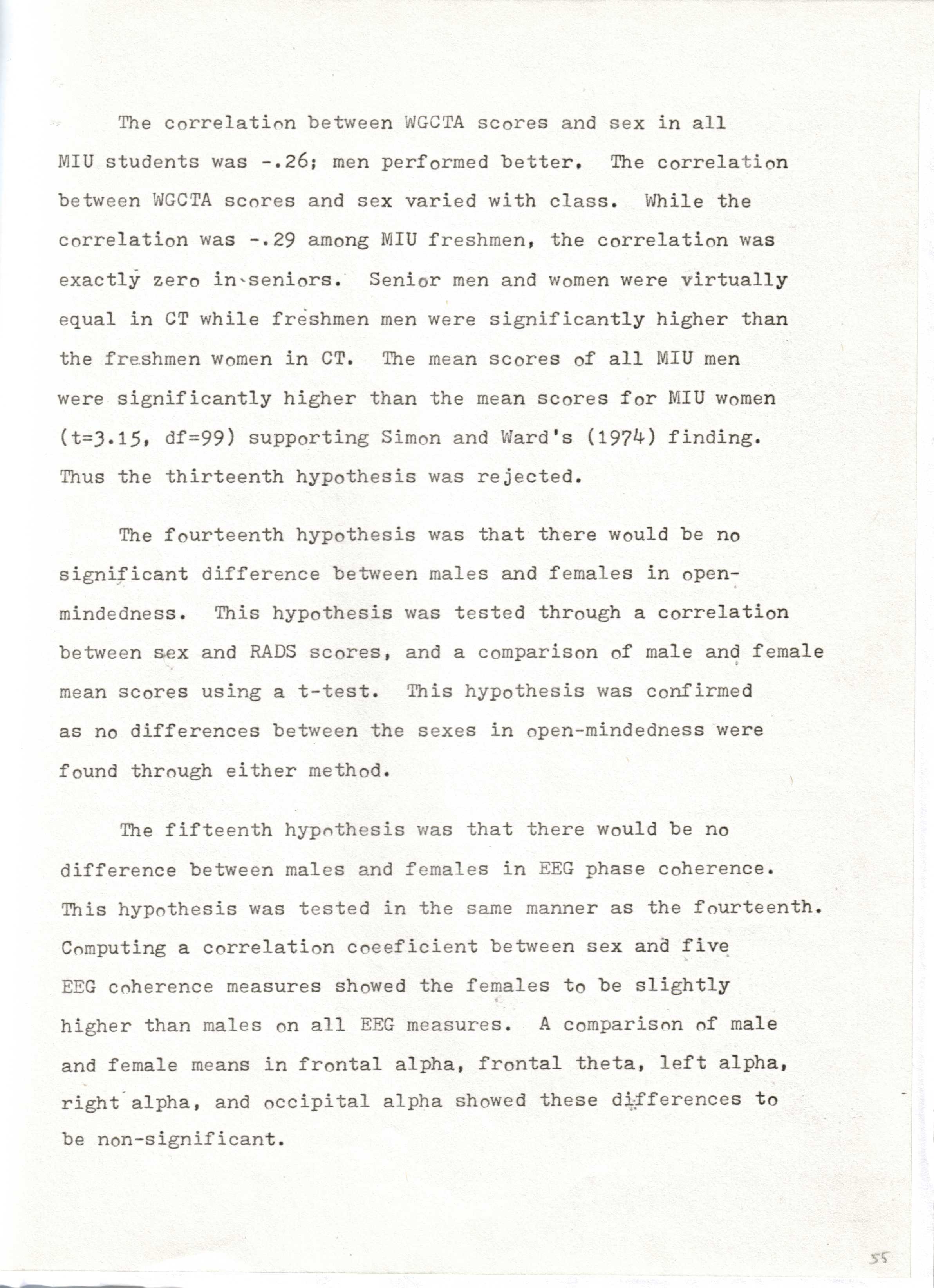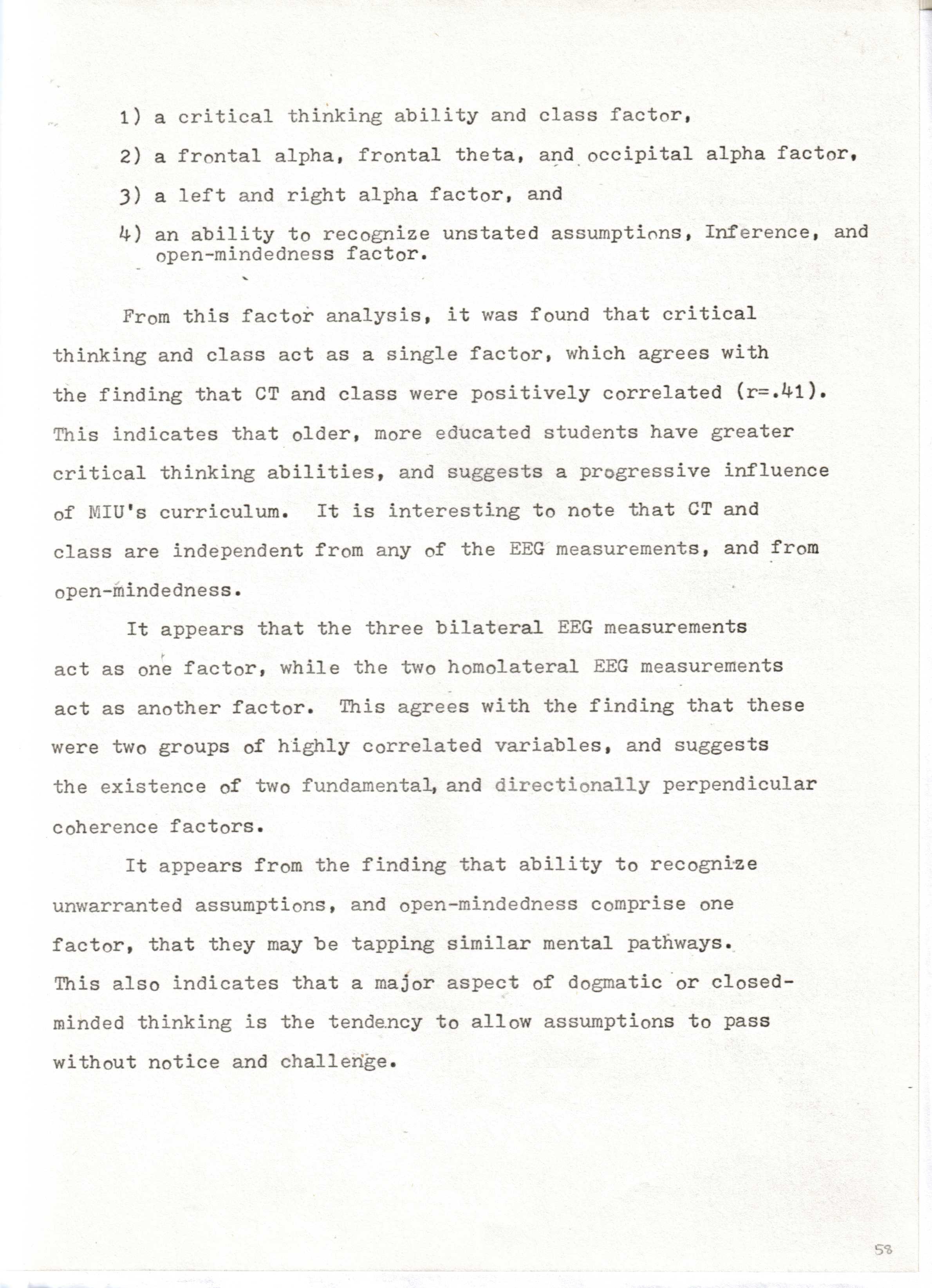
ctomeegmiu55.jpg
|
The correlation between WGCTA scores and
sex in all
MIU students was -.26; men performed
better. The correlation
between WGCTA scores and sex varied with
class. While the
correlation was -.29 among MIU freshmen
the correlation was
exactly zero in seniors. Senior men and
women were virtually
equal in CT while freshmen men were
significantly higher than
the freshmen women in CT. The mean scores
of all MIU men
were significantly higher than the mean
scores for MIU women
(t=3.15, df=99) supporting Simon and Ward's
(1974) finding.Thus the thirteenth hypothesis was
rejected.
The fourteenth hypothesis was that there
would be no
significant difference between males and
females in open-mindedness. This hypothesis was tested
through a correlation
between sex and RADS scores, and a
comparison of male and female
mean scores using a t-test. This hypothesis
was confirmed
as no differences between the sexes in
open-mindedness were
found through either method.
The fifteenth hypothesis was that there
would be no
difference between males and females in EEG
phase coherence.
This hypothesis was tested in the same
manner as the fourteenth.
Computing a correlation coefficient between
sex and five
EEG coherence measures showed the females
to be slightly
higher than males on all EEG measures. A
comparison of male
and female means in frontal alpha, frontal
theta, left alpha,
right alpha, and occipital alpha showed
these differences to
be non-significant.
|

ctomeegmiu56.jpg
|
The final step in the analysis of data was to determine
the unique factors which accounted for the
major portions of
the variance in the correlation matrix of
fourteen variables. This was accomplished using the BIOMED
statistical package
of programs on MIU's PDP-11 computer.
Eigenvalues. or uniqueness coefficients on
an unrotated
factor loading pattern revealed four
principal components.
The unrotated factors responsible for major
portions of the
variance in the matrix were determined to
be:
1) a critical thinking factor combined with
lack of
EEG frontal alpha and theta coherence,
2) an EEG phase coherence factor combining
all measures,
frontal, lateral, and occipital,
3) a Dogmatism, class, frontal theta. and
lack of left
and right alpha coherence factor,
4) a Dogmatism, frontal alpha, lack of
occipital alpha,
lack of inference ability, and lack of
ability to recognize assumptions factor.
The factor loadings pattern was then
rotated to maximize
the main factors and minimize those factors
which had eigenvalues close to zero. Kaiser's rule was
used--if a factor
has an eigenvalue of less than one, it will
be generally
uninterpretable and should be rejected
prior to rotation.
The varimax rotation of the correlational
matrix yielded four
more refined factors (See Table 4): |

ctomeegmiu58.jpg
|
1) a critical thinking ability and class
factor,
2) a frontal alpha, frontal theta, and
occipital alpha factor,
3) a left and right alpha factor, and
4) an ability to recognize unstated
assumptions, Inference, and
open-mindedness factor.
From this factor analysis, it was found
that critical
thinking and class act as a single factor,
which agrees with
the finding that CT and class were
positively correlated (r=.41).
This indicates that older, more educated
students have greater
critical thinking abilities, and suggests a
progressive influence
of MIU's curriculum. It is interesting to
note that CT and
class are independent from any of the EEG
measurements, and from
open-mindedness.
It appears that the three bilateral EEG
measurements
act as one factor, while the two
homolateral EEG measurements
act as another factor. This agrees with the
finding that these
were two groups of highly correlated
variables, and suggests
the existence of two fundamental and
directionally perpendicular
coherence factors.
It appears from the finding that ability to
recognize
unwarranted assumptions, and
open-mindedness comprise one
factor, that they may be tapping similar
mental pathways.
This also indicates that a major aspect of
dogmatic or closed-minded thinking is the tendency to allow
assumptions to pass
without notice and challenge.
|

ctomeegmiu57.jpg
|
Table 4
Varimax Rotation .
Factor Loadings Pattern
| Variables |
Factor 1:
Watson (CT) |
Factor 2:
Frontal |
Factor 3:
Lateral EEG |
Factor 4:
Recognition of
Assumptions, Inference & Open-Mindedness |
| Class |
.623 |
.401 |
-.223 |
-.064 |
| Sex |
-.139 |
.289 |
.096 |
.012 |
| Inference |
.452 |
.088 |
-.182 |
.598 |
| Recognition of Assumptions |
.345 |
.002 |
.101 |
.812 |
| Deduction |
.778 |
-.210 |
-.149 |
.092 |
| Interpretation |
.846 |
-.182 |
.160 |
.059 |
| Evaluation |
.819 |
-.234 |
.073 |
-.066 |
| Watson (CT) |
.915 |
-.158 |
.003 |
.351 |
| Rokeach (OM) |
.257 |
.142 |
-.166 |
-.783 |
| Frontal alpha |
-.063 |
.808 |
.266 |
-.156 |
| Frontal theta |
-.031 |
.879 |
.015 |
-.169 |
| Left alpha |
.012 |
.152 |
.919 |
.140 |
| Right alpha |
-.020 |
.082 |
.919 |
-.010 |
| Occipital alpha |
-.197 |
.699 |
-.112 |
.306 |
| Uniqueness coefficients |
|
|
|
| Eigenvalues |
3.669 |
2.373 |
1.955 |
1.941 |
Factor loading values greater than .500 are
underlined for clarity |

ctomeegmiu59.jpg
|
Chapter 5: Other findings An item analysis of the Rokeach Adult
Dogmatism Scale
revealed some inconsistencies, and possible
shortcomings of
the RADS. Both students high in
open-mindedness, and low in
open-mindedness tended to agree with items
#15 and #17 of the
RADS:
15) While I don't like to admit this even
to myself, my
secret ambition is to become a great man,
like
Einstein, or Beethoven, or Shakespeare.
17) If given the chance I would do
something of great
benefit to the world.
According to Rokeach, agreement with these
statements
would be an indication of dogmatism.
However, their predictive
validity of the total RADS score was very
low. These statements
may not necessarily be dogmatic statements.
The students had many comments about the RADS which they
included on their answer sheets. Some
responses were:
"Who wrote these questions?”
"Who made this test? Not you I hope.“
"Is this a test for insecurity?'
"I feel sorry for people who‘d feel like
that."
The RADS evoked laughter from two seniors
who found the statements "ridiculous'. One girl found the
RADS "too negative"
to complete.
An analysis of the WGCTA found that MIU
seniors and
freshmen did best on the subtest of ability
to recognize
unstated assumptions. |

ctomeegmiu60.jpg
|
As the MIU students performed close to, or
better, than
average in critical thinking ability,
another pilot study in
belief systems was performed. The WGCTA is
an indicator of
how logically a person arrives at what he
believes, and the
RADS is an indicator of how tolerant a
person is of other
beliefs. A questionnaire was designed by the
experimenter to
determine what type of things,
specifically, the MIU students
believe in.
The test was called the Human Potential
Questionaire (HPQ),
which consists of 13 potential human
abilities. The subjects
are asked to state true or false whether
they believe these
abilities are 1) possible 2)their personal
experience, and
3) important abilities to achieve. A sample
HPQ is found in the Appendix of this paper.
The HPQ was administered to 14 MIU freshmen
and 14 MIU
upperclassmen (sophomores, juniors, and
seniors). The subjects
were chosen after classes among volunteers,
attempting to
sample as close to randomly as possible.
The test was short
enough that all students who were asked to
fill it out did
so willingly.
The results of the questionnaire indicate
that MIU freshmen
and seniors have a very optimistic view of
man's full potential.
Among the abilities they believed were
possible for man to
achieve were: levitation by mere intention,
ability to know
the future, become immortal, and see
objects hidden from view.
|